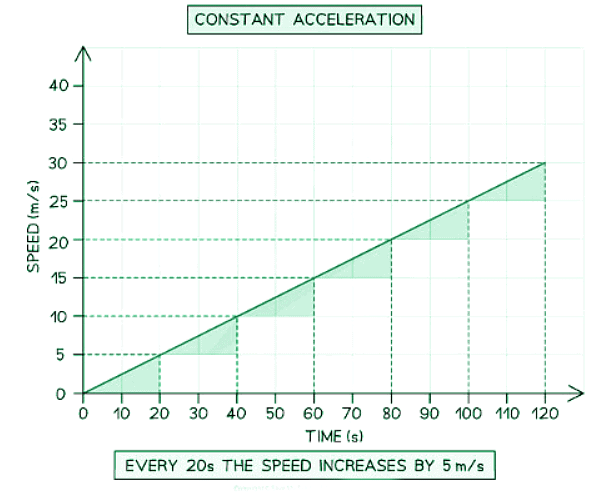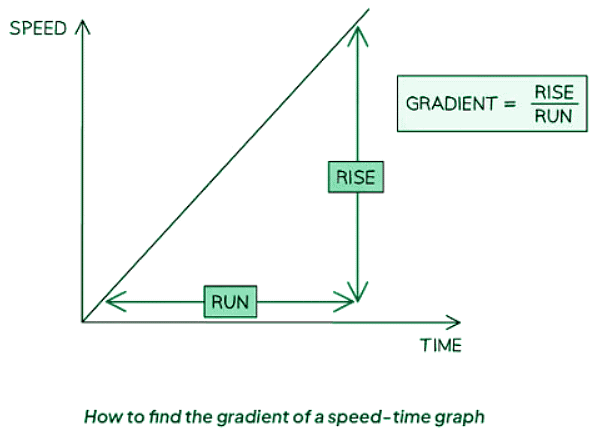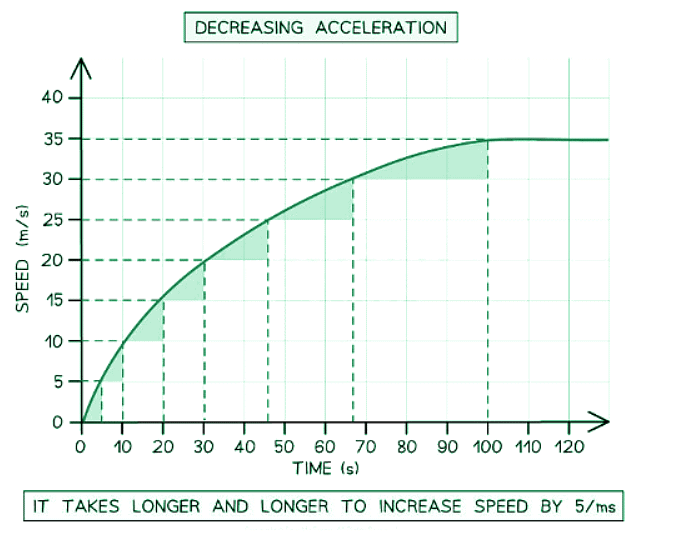Year 11 Exam > Year 11 Notes > Physics for GCSE/IGCSE > Calculating Acceleration from Speed-Time Graphs
Calculating Acceleration from Speed-Time Graphs | Physics for GCSE/IGCSE - Year 11 PDF Download
Interpreting Speed-Time graphs
- If there is a change in an object's speed, then it is accelerating
- An object may accelerate at a steady rate, this is called constant acceleration.
- On a speed-time graph, constant acceleration is shown as a non-horizontal straight line.

- An object may accelerate at an increasing rate.
- On a speed-time graph, this would be shown as an upward curve with an increasing gradient.

- On a speed-time graph, this would be shown as an upward curve with an increasing gradient.
- Objects can also accelerate at a decreasing rate, which is represented by an upward curve on a speed-time graph with a gradually lessening gradient.

Understanding Deceleration
- Deceleration occurs when an object's speed decreases over time, resulting in a negative acceleration.
- On a speed-time graph, deceleration is represented by a downward line.
- It can be constant, increasing, or decreasing depending on the shape of the curve.
- Example: Imagine a car hitting the brakes and gradually coming to a stop. The corresponding speed-time graph would show a downward line illustrating deceleration.
Question for Calculating Acceleration from Speed-Time GraphsTry yourself: What does a non-horizontal straight line on a speed-time graph indicate?View Solution
Calculating Acceleration
- The acceleration of an object can be determined by analyzing the slope of a graph depicting its speed over time.


The document Calculating Acceleration from Speed-Time Graphs | Physics for GCSE/IGCSE - Year 11 is a part of the Year 11 Course Physics for GCSE/IGCSE.
All you need of Year 11 at this link: Year 11
|
127 videos|148 docs|35 tests
|
FAQs on Calculating Acceleration from Speed-Time Graphs - Physics for GCSE/IGCSE - Year 11
| 1. How do you calculate acceleration from a speed-time graph? |  |
Ans. To calculate acceleration from a speed-time graph, you need to find the slope of the graph. The slope of the graph represents the rate of change of speed, which is the acceleration. The steeper the slope, the greater the acceleration.
| 2. What does a horizontal line on a speed-time graph indicate about acceleration? |  |
Ans. A horizontal line on a speed-time graph indicates that the object is moving at a constant speed, with zero acceleration. This is because there is no change in speed over time when the line is horizontal.
| 3. How can you determine if an object is accelerating or decelerating from a speed-time graph? |  |
Ans. If the speed-time graph has a positive slope, the object is accelerating. If the slope is negative, the object is decelerating. A flat line indicates constant speed with zero acceleration.
| 4. Can acceleration be calculated at a specific point on a speed-time graph? |  |
Ans. Yes, acceleration can be calculated at a specific point on a speed-time graph by finding the slope of the tangent line to the curve at that point. The steeper the tangent line, the greater the acceleration at that specific point.
| 5. How does the shape of a speed-time graph affect the acceleration of an object? |  |
Ans. The shape of a speed-time graph can indicate different types of acceleration. For example, a curve on the graph may represent changing acceleration, while a straight line may indicate constant acceleration. The steepness of the curve or line also reflects the magnitude of acceleration.

|
Explore Courses for Year 11 exam
|

|
Signup for Free!
Signup to see your scores go up within 7 days! Learn & Practice with 1000+ FREE Notes, Videos & Tests.
Related Searches


















